北斗卫星导航系统的毫米级精度变形监测算法与实现
大坝变形监测的研究现状与发展趋势

文章编号:100722284(2006)022*******大坝变形监测的研究现状与发展趋势李红连,黄丁发,陈宪东(西南交通大学土木工程学院,成都610031) 摘 要:大坝变形观测是其安全监测的重要组成部分。
介绍和分析了各种常规的变形观测方法以及最新监测技术:激光准直、传感器、全站仪、GPS自动变形监测系统;给出了大坝变形观测的发展趋势:多天线GPS、多种卫星导航定位系统组合和多传感器智能数据融合的大坝变形自动监测系统。
关键词:大坝;变形监测;全站仪;GPS;数据融合 中图分类号:TV698.1+1 文献标识码:B 20世纪以来,相继发生了美国Teton土石坝、法国Mal2 passet拱坝、意大利Vajaut拱坝、我国板桥和石漫滩等水库的跨坝事件,给相关国家带来了惨重的灾害和巨大的经济损失,引起人们对大坝安全监测的高度重视。
大坝安全监测的主要项目有变形监测、渗流监测、应力应变监测、温度监测和大坝周围环境监测等。
由于变形监测能直观地反映大坝运行性态,许多大坝性态出现异常,最初都是通过变形监测值出现异常得到反映的,因此变形监测项目列为大坝安全监测的首选监测项目[1~3]。
在我国大坝变形监测领域中,经历了20世纪50年代开始研究和使用的人工变形监测系统,70年代开始研究和使用的以传感器、激光技术和全站仪TPS为基础的自动化变形监测系统以及90年代开始研究的GPS自动化变形监测系统等发展阶段。
1 人工变形监测系统1.1 水平位移监测(1)视准线法是在大坝两端稳定的基岩上埋设固定工作基点,其连线构成视准线,沿视准线在坝体上每隔适当的距离埋设水平位移观测点,在这2个固定的工作基点上架设经纬仪观测这些测点相对视准线的偏角,从而计算得到位移。
对于坝长超过500m和折线型坝,需在坝体中间和转折处增设非固定的工作基点,但应考虑该基点的位移。
(2)引张线法是在大坝两端工作基点间拉紧1根钢丝作为基准线,然后观测坝体上各测点对该基准线的距离变化量来计算水平位移。
北斗卫星导航系统的毫米级精度变形监测算法与实现 学位论文

北斗卫星导航系统的毫米级精度变形监测算法与实现摘要:研究了北斗卫星导航系统(BeiDou Navigation Satellite System,BDS)毫米级精度变形监测算法。
首先改进了TurboEdit 方法,以能够探测到1周的小周跳;针对BDS星座结构给出更为高效的独立双差观测值搜索方法;对于模糊度固定,采用决策函数和序贯模糊度固定相结合的方法。
在此基础上,研制了BDS变形监测软件。
最后,利用变形监测试验平台的实测数据,从星座分布、解算精度等方面分析了BDS在变形监测中应用的可行性。
结果表明,目前在试验区域内BDS与GPS在卫星几何分布等方面基本相当。
BDS的短基线解算精度略低于GPS,但仍可达到平面1 mm以内、高程2 mm以内的精度水平。
关键词:北斗卫星导航系统变形监测软件实现精度分析Abstract: The deformation monitoring algorithm with millimeter level precision based on BeiDou Navigation Satellite System (BDS) was researched. The TurboEdit method was improved to detect small cycle slips, e.g. 1 cycle. Focusing on BDS constellation, a more efficient algorithm used to construct double-differenced observations was developed. The Bootstrap+Decisionfunction method was utilized to improve the probability of biases fixing. Based on the improved algorithm above, a deformation monitoring software based on BDS was achieved. Afterwards, the availability of BDS in the field of deformation monitoring was analyzed in terms of satellites distribution and precision and accuracy of solutions, utilizing the observations acquired from the experimental platform. The conclusion was drawn that currently BDS is similar to GPS in terms of satellites distribution in the test area. The precision of short baselines derived from BDS is better than 1 mm for the horizontal components, better than 2 mm for the vertical components, which is still a little lower than GPS.Key words: BeiDou Navigation SatelliteSystem deformationmonitoring softwareachievement precision analysis随着各种大型结构体的大量涌现以及滑坡、泥石流等地质灾害的频繁发生,变形监测研究的重要性日益突出,变形监测理论和技术方法也在迅速发展。
项目名称推荐单位意见-科技处

三、项目简介
目前全国有各类矿山10万多座,而矿山开采诱发的沉陷区破坏和边坡失稳是 最重要的灾害问题之一。目前每年仅煤炭开采所造成的沉陷区就达12.5万公顷左 右,再加上露天滑坡造成的巨大经济损失和社会影响,如何辨识开采诱发灾变问 题和动态预测预警亟待深化研究。本项目通过对国家973、863和科技支撑等项目 的系统研究,取得了如下创新性成果:
该项目在矿山、自然山体滑坡及水利水电等行业240多家企业或政府部门得 到了推广应用,经济和社会效益显著,获省部级科技进步一等奖7项、二等奖7 项;国家授权发明专利14项、实用新型专利33项、软件著作权64项、发表高水平 论文300余篇、出版专著10余部。
鉴定该项目突破了现有的形变风险评价理论,研发了新型高精度监测装备, 应用效益显著,推动了本领域的科技进步和学科发展,对照国家科学技术奖授奖 条件,推荐申报国家科技进步一等奖。
3
四、客观评价
1、技术创新性与先进性 项目“高地应力作用下露天转地下开采安全控制关键技术”2012年通过中国 有色金属工业协会组织鉴定,其鉴定结论为“研究成果整体达到国际先进水平, 其中创建边坡稳定状态精细化评价体系具有国际领先水平”;该成果获得2012年 中国有色工业科学技术一等奖。 项目“露井复合开采滑坡风险辨识及其雷达监测系统的研发”2015年通过中 国有色金属工业协会组织鉴定,其鉴定结论为“研究成果整体达到国际先进水平, 其中干涉雷达装备研发具有国际领先水平”;该成果获得2015年中国有色工业科 学技术一等奖。 项目“布沼坝露天五期扩建安全控制关键技术的研究”2010年通过云南省科 技厅组织鉴定,其鉴定结论为“研究成果达到国际先进水平”;该成果获得2010 年云南省科技进步一等奖。 项目“焦家式黄金矿床浅部复采区地表沉陷与灾变预测研究”2010年通过中 国黄金协会组织鉴定,其鉴定结论为“研究成果整体达到国际先进水平”;该成果 获得2010年中国黄金协会科学技术一等奖。 项目“金属矿床充填开采岩体移动监控技术及应用”2009年通过甘肃省科委 组织鉴定,其鉴定结论为“研究成果整体达到国际先进水平”;该成果获得2015 年国家安全生产监督管理总局第六届安全生产科技成果一等奖。 研发设备2013年通过国家技术监督局授权国家光电检测中心的检测,其技术 参数达到国际同类产品最高水平。 在2009年国产空间信息系统软件评测中获国家遥感中心嘉奖,“测地形双频 GPS接收机”获评2012-2014年度测卫星导航定位科学技术特等奖”、2011年成果“基 于自主知识产权的测地型双频接收机”获得国家测绘地理信息局“卫星导航定位 科学技术一等奖”、二等奖2项、三等奖3项。
北斗卫星说明文800字

北斗卫星系统是中国自主研发的全球卫星导航系统,它是一个集成了多颗卫星定位技术、通信技术、数据处理技术等多个领域的先进技术的综合性系统。
以下是对北斗卫星系统的详细说明。
一、北斗卫星系统的背景在全球范围内,已经有多个卫星导航系统相继建立并投入使用。
美国GPS系统是最为成熟的系统之一,欧洲的Galileo系统和俄罗斯的GLONASS系统也具有一定的竞争力。
这些系统的建立,为全球范围内的定位、导航和通信提供了重要的支持。
在这样的背景下,中国也开始了自己的卫星导航系统建设,这就是北斗卫星系统。
二、北斗卫星系统的组成北斗卫星系统由多颗卫星组成,包括地球同步轨道卫星和倾斜地球同步轨道卫星。
这些卫星分布在不同的轨道上,通过相互配合,为地面用户提供高精度、高可靠的定位、导航和通信服务。
北斗卫星系统的地面设施包括地面控制中心、信号接收站、数据处理中心等。
地面控制中心负责接收和处理卫星信号,进行数据处理和定位解算,并将结果发送给用户终端。
三、北斗卫星系统的特点1. 高精度:北斗卫星系统提供的定位精度非常高,可以达到厘米级甚至毫米级的精度。
这对于需要进行高精度定位的应用场景非常有用,比如自动驾驶、精密农业等。
2. 覆盖范围广:北斗卫星系统可以覆盖全球范围,不受地域和天气的影响,可以为全球范围内的用户提供服务。
3. 兼容性和互操作性:北斗卫星系统支持与其他卫星导航系统的兼容和互操作性,这意味着用户可以使用任何兼容的设备来接收北斗卫星系统的信号,从而获得更好的定位和通信体验。
4. 短报文通信:除了定位服务外,北斗卫星系统还提供了短报文通信服务。
用户可以通过卫星网络发送和接收简短的信息,这在应急救援、旅行和商业活动中具有很大的实用价值。
四、北斗卫星系统的应用北斗卫星系统在很多领域都有广泛的应用,包括交通运输、公共安全、天气预报、精准农业、海洋渔业、航空航天等。
在交通运输领域,北斗卫星系统可以为船舶、飞机等提供精确的定位和导航信息,提高交通安全性;在公共安全领域,北斗卫星系统可以为执法部门提供高精度的定位信息,提高破案效率;在天气预报方面,北斗卫星系统可以为气象部门提供更准确的观测数据,提高天气预报的准确度;在精准农业方面,北斗卫星系统可以为农业设备提供精确的定位信息,提高生产效率。
211131695_基于坐标标定的北斗RTK和UWB的变电站定位技术

实现对变电站作业人员的一举一动操作进行安全把 于测试时的电磁干扰。因此,定位技术在实际应用
控,可以有效避免不良事故和安全防护不到位的情 过程当中,其误差范围并不会对变电站作业人员的
况出现。同时,可以实现室内外对作业人员位置进 监控与定位等方面造成影响。
3 基于北斗RTK+UWB的变电站定位技术研究 3.1 实时动态测量分析
实时动态测量技术(Real Time Kinematic,
RTK)[4]作为北斗系统中的一项重要技术,主要是 以相对定位为根本,借助基准站和流动站等两者之 间的协同作业来实现。其工作流程主要为:当基准
CCoHpINyAriEgLhECt©TR博IC看AL网EQ. UAIlPlMREiNgThtINs DRUeSsTeRrYved.
带宽定位技术等。这些定位技术在电力系统中的 围,误入带电间隔,由于与带电设备安全距离不
应用,可以有效保障作业人员的安全。但由于变 够,危及电网及现场作业人员安全的问题。传统作
电站环境因素的影响,作业人员在进入危险区域 业范围人工围栏网布置高度有限,无法对大型作业
时,无法实现对人员位置的精准定位。因此,本 工器具的作业范围进行有效的提醒与保护。为了更
内定位研究方向得到广泛的应用。该项定位技术能 平面定位精度达±2mm+0.5ppm,高程定位精度达
2023.04.DQGY
够实现从纳秒到微秒之间不等的非正弦波窄脉冲, ±5mm+0.5ppm。因此,在变电站运维管控和生产
进行数据信息传输。同时,结合美国FCC相关章程 作业等方面应用时,利用GNSS增强定位能够对变电
PRODVCT AND TECHNIC‖产品与技术‖
站在接收到北斗卫星所观测的数据之后,通过该计 网、北斗定位终端和可穿戴移动设备、UWB室内基
卫星导航定位基准站网及其在变形监测中的应用

GPS
GPS现代化
COMPASS
网 技络 术
VRS
FKP MAC CBI
ARSNet / VENUS
RTK I TRF
系 发 展
美 国 坐 标
行度我 业国
网高 和精
CORS
省 市 级
1980
I TRF93 I TRF92 I TRF91 I TRF90 I TRF97 I TRF89 I TRF96 I TRF88 I TRF94
6
GNSS基准站网的发展历史
n 国际上GNSS基准站网的发展历史:IGS机构
1987 年 , NGS 建立 了 高精 度 大地参考网:HARN
1990年,IGS的基准站网扩展 至南半球;截止1991年,IGS 的21个 基准站 已覆 盖除南极 洲以外的所有大陆
IGS连续运行GNSS基准站Байду номын сангаас(数目超过500个)
S035 S023
Y
Z X
(BCS)
W009
ITRF2014水平速度场(Al Z et al. 2016)
武汉白沙洲大桥安变徽形省监水测平速度场 西龙池水库大坝变形监测 18
GNSS变形监测系统
n 以GNSS技术为核心,综合利用卫星重力、InSAR、GBSAR、
SLR等多种监测手段,结合传感器采集的气象、水文等观测资 料,构建了自动化变形监测系统,实现了自动化、连续、实 时、高精度的动态三维监测
GNSS在大坝变形监测中的应用
n 隔河岩大坝变形监测系统
Ø1996年,成功地将GPS卫星定位技术应用于实时大坝变形监测 Ø综合采用了微波、光纤等通讯手段组成了局域网络,实时化,自动化 Ø数据采集到变形分析的处理时间小于10分钟,创造了当时世界上GPS
变形监测
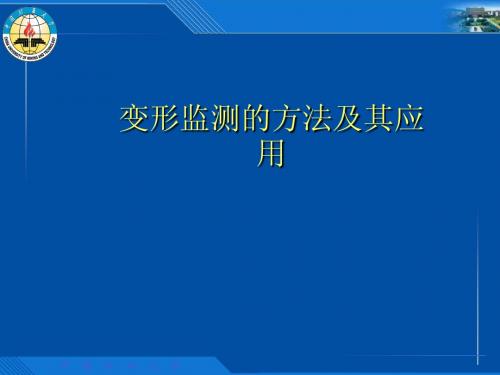
中 国 矿 业 大 学
测量原理
探头内的感应电路在探头接近感应环时,将引起蜂鸣器报警 ,并使指示器上指针偏转。当指针达到蜂值,即探头中心正好对 准感应环时,利用电缆和标尺上的刻度,便可测得探头中心所在 的深度。根据一定时间间隔内前后两次的测量结果,可计算出不 同深度(感应环所在位置)岩层的垂直位移以及每一段内岩层的 竖向伸长或压缩量。为获得绝对的位移值,至少应有一个感应环 (如孔底附近)埋在稳定岩石中,或者有一个感应环(如孔口附 近)用其它方法测得绝对位移值。
3.1 岩体内部下沉测量(钻孔伸长仪)
安装好的下沉测量系统如图所示。
1-基准架;2-读数装置、卷缆轮;3-水泥浆;
4-充填砂浆;5-用粘结剂和胶带密封的感应环; 6-感应环;7-倾斜仪套管接头;8-倾斜仪套管; 9-注浆阀门;10-重锤;11-探头; 12-用粘结 剂和胶带密封的软管接头;13-用尼龙丝或胶带夹 固定的软管接头; 14-固定在刚性管上的软管末端。
点云数据
特征线提取 两次特征线比较
最终变形数据
中 国 矿 业 大 学
实例:焦炉和烟囱变形监测的扫描数据
1号焦炉点云数据 2号焦炉点云数据
点云数据截面截取 中 国 矿 业 大 学
截取后的点云数据和特征 线数据
3 岩体内部观测系统
岩层内部观测站测点一般布设在岩层内部的钻孔中,用于研究 岩层内部的移动和变形规律。
指标
扫描距离 距离测量精度 单点定位精度
数值
最远350m 7mm@100m 6mm@50m,12mm@100m
激光波长
扫描范围
脉冲532 nm
360° x 60° 连续扫描
中 国 矿 业 大 学
2.3三维激光扫描技术的特点
基于物联网和北斗监测云的水库大坝结构安全监测技术研究与应用

基于物联网和北斗监测云的水库大坝结构安全监测技术研究与应用摘要:研究了水库大坝安全监测特点,基于监测物联网和云技术构建了水库大坝安全监测系统, 实现了水库大坝安全数据的自动采集、信息化管理、状态预警与移动管理整套技术体系。
以浙江余杭8个水库为研究试点,将关键技术和研究成果进行应用,建立了水库坝体安全监管云平台,并在基于GNSS的坝体三维变形预警分析上做了深入的分析与探讨,验证了整个技术体系的可行性,具有智慧水库示范应用意义。
关键字:水库大坝安全,监测物联网,GNSS变形监测,智慧水库Research and Application of Dam Structural Safety Monitoring based on Monitoring IoT and Cloud ServiceAuthor:Wang Shuai,Shen Qiangyong,Shen Yuxiang,Zhang ChunyanAbstract: The characteristics of dam structural safety monitoring are studied, anda dam safety monitoring system has been constructed based on monitoring IoT and cloud service, which realizes the automatic collection of safety data, information management, state warning and mobile management. Taking 8 reservoirs in Yuhang, Zhejiang Province as the research pilot, the key technologies and research results are applied to establish the dam safety monitoring platform, and GNSS three-dimensional deformation monitoring analysis has been deeply discussed. The feasibility of the whole technical system has been verified and it is a demonstration application of intelligent reservoir.Key Words: Reservoir Dam Safety, Monitoring IoT, GNSS Deformation Monitoring, Intelligent Reservoir1引言水库综合环境较为复杂,水坝工程构筑物表面、内部变化以及周边环境的安全状态往往难以察觉,在蓄水期和长期运行管理中,存在安全隐患,一旦出现异常状态,必须及时发现并妥当处理,否则可能导致严重后果,危及生命财产安全。
土木工程测量新技术与方法研究

土木工程测量新技术与方法研究在土木工程领域,测量工作是至关重要的环节,它为工程的设计、施工和运营提供了基础数据和精确的位置信息。
随着科技的不断进步,土木工程测量领域也涌现出了一系列新技术和新方法,这些技术和方法的应用极大地提高了测量的精度、效率和可靠性,为土木工程的发展注入了新的活力。
一、全球导航卫星系统(GNSS)技术全球导航卫星系统(GNSS)是目前土木工程测量中应用最为广泛的技术之一。
GNSS 系统包括美国的 GPS、俄罗斯的 GLONASS、中国的北斗卫星导航系统以及欧盟的 Galileo 等。
这些卫星系统能够提供全球范围内的高精度定位服务,其定位精度可以达到厘米级甚至毫米级。
在土木工程中,GNSS 技术主要用于控制测量、地形测量、变形监测等方面。
例如,在大型桥梁、高层建筑等工程的施工中,通过在施工现场建立 GNSS 控制网,可以实现对施工过程的精确控制,确保工程的质量和安全。
同时,GNSS 技术还可以用于对大坝、山体等的变形监测,及时发现潜在的安全隐患。
然而,GNSS 技术也存在一些局限性,如在城市峡谷、隧道等信号遮挡严重的区域,其定位精度会受到影响。
此外,GNSS 信号容易受到干扰,因此在使用时需要采取相应的措施来提高其可靠性。
二、激光扫描技术激光扫描技术是一种快速获取物体表面三维信息的测量技术。
它通过向物体发射激光束,并接收反射回来的激光信号,从而计算出物体表面各点的坐标和距离。
在土木工程中,激光扫描技术可以用于建筑物的建模、古建筑的保护、隧道的检测等方面。
例如,在对古建筑进行保护时,通过激光扫描技术可以快速获取古建筑的精确三维模型,为后续的修复和保护工作提供依据。
在隧道检测中,激光扫描技术可以检测隧道的变形、裂缝等病害,为隧道的维护和管理提供支持。
与传统的测量方法相比,激光扫描技术具有速度快、精度高、非接触等优点。
但同时,激光扫描技术也存在数据量大、处理复杂等问题,需要使用专业的软件进行处理和分析。
北斗导航系统应用于测绘地理信息服务的标准化技术研究

北斗导航系统应用于测绘地理信息服务的标准化技术研究随着社会的发展和时代的变迁,科学技术也在不断的更新和发展,诸多科技成果不断地在人们的生产生活中渗透和融入,极大的便捷了人们的生活,同时也提升了生产效率,以北斗导航系统的应用为例,此科技成果在人们生活中应用,不仅提高了人们的生活质量,同时也对测绘行业的发展起到了重要的推动性作用,而笔者则主要针对北斗卫星导航系统应用与测绘地理服务中的标准化技术进行了分析,以下为详述。
标签:北斗导航系统;应用;测绘底细利息服务;标准化技术我国的北斗导航系统处于不断完善的过程,这一技术的应用对于我国地理测绘行业和定位系统的发展具有重要的推动性作用,可见,合理的应用北斗导航系统极具战略性意义。
将这一北斗导航系统充分的应用到地理测绘中,可以有效的提高测量的精准程度,同时也会确保数据测绘的准确性,逐渐的提高行业的发展水平,也会对社会化服务信息资源开发行业的发展具有重要的推动性作用,切实凸显测绘手段的科学性和高效性,将其技术优势融入到实际的生活中,进而为地理测绘行业的发展指明方向,也会为BDS空间信号的质量进行积极地指导和有效的定位,最终促使BDS的测绘地理信息技术的应用更具标准化和规范化。
而笔者针对北斗导航系统的技术特征进行了分析,而后对测绘行业对于此技术的实际需求进行了探究,最后针对BDS测绘地理技术的实际发展情况,对其中的技术标准的规范手段进行了分析。
1、对于BDS技术特征分析1.1对于BDS覆盖范畴分析当前,我国的BDS所覆盖的区域在东经五十五度至一百八十度之间,北纬五度至五十五度之间,其中包括我国领土的全部范围以及亚太地区的全部面积,可以为亚太地区的天候、天时、导航以及通信服务等提供高强度、高精准度的服务,BDS技术的应用,对于我国的地理测绘行业的发展奠定了良好的基础,同时对于空間范围的整合也起到了一定的促进作用。
预计到二零二零年将实现BDS 的全球覆盖,空间部分由三十五颗卫星构成,其中的卫星数量将会随着空间布局的变化也会随之生长[1]。
基于北斗技术的萨雷兹湖大坝变形监测应用

图1 萨雷兹湖和Usoi大坝图2 基于北斗技术的萨雷兹湖大坝变形监测技术构架三、监测系统具体技术1.便携式一体化监测终端技术监测终端的长期供电和便携运输安装均是本系统建设的难点。
考虑到监测区域光照足、无交通的条件,本项目通过对传统的接收机进行改造,使其集成太阳能供电模块、北斗精度定位模块、串口数据输出3 北斗一体接收机(左)和便携式监测墩(右)目组采用数据功率仪对用电单元进行功耗评估,根据实际功耗设计了大功率太阳能光伏板和大容量电池组,并利用太阳能控制器监控系统进一步对功耗单元进行验证,可以保障连续条件下监测系统的稳定供电。
图4为太阳能供电系统与安装实物图。
图4 太阳能供电系统(左)与安装实物(右)图5 大坝监测系统通信技术方案4.复杂环境气候下北斗实时毫米级可靠针对萨雷兹湖大坝的毫米级定位需求,采用了基于环境建模的精密单点定位(PPP)和实时动态定位(RTK)的联合解算策略。
首先采用环境建5.监测系统完好性监测与防控技术对于监测系统完好性,主要涉及对卫星端、终端、通信端三方面进行监测和防控。
对于卫星端,利用全球连续监测评估系统(iGMAS)全球连续跟踪站对卫星轨道机动进行实时探测并对北斗机动卫图6 萨雷兹湖大坝上北斗监测终端的安装实景图图7 基于北斗技术的萨雷兹湖大坝变形实时监测系统六、结束语中塔联合团队通过设备研制、定位算法融合、通信组网等关键技术攻关,建立了一套适用于萨雷兹湖特定条件的北斗变形监测系统。
目前系统所有指标正常,运行状态良好,监测系统各项指标满足大坝的监测需求,可持续为大坝提供高精度监测服务,在国际减灾方面作出贡献。
此外,为进一步推进和推广北斗应用,结合桥梁、尾矿、滑坡、楼宇、大坝等广泛的变形监测需求,联合团队基于萨雷兹湖变形监测系统研制并推出“一带一路”北斗泛在变形监测服务平台,可为用户提供北斗实时高精度变形监测数据解算技术服务。
致谢:感谢中国科学院国际合作伙伴计划项目的资助,感谢中科院中亚生态与环境研究中心、塔吉克斯坦科学院和紧急情况与民防委员会的大力支持。
北斗+InSAR 技术在大坝变形及周边地质灾害监测中的应用
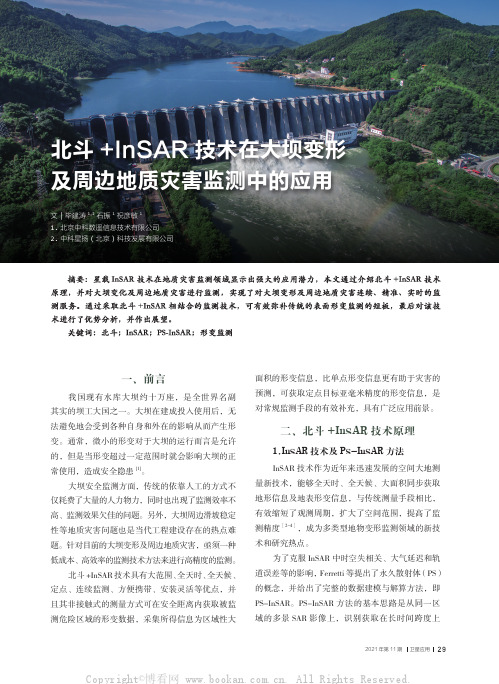
北斗+InSAR技术在大坝变形及周边地质灾害监测中的应用
文|毕建涛1,2 石振1 祝彦敏1
1.北京中科数遥信息技术有限公司
2.中科星扬(北京)科技发展有限公司
图2 InSAR监测大坝周边地质灾害
图3 位移监测结果3.地面沉降监测
库坝建设、水体蓄存地下水的压力变化、人类活动建设导致地质活动,极易造成周边路基和建设用地沉降。
不均的地面沉降严重地危害着城市建筑,当建筑物塌陷、房屋倒塌又危及人类生命安全、财产。
近年来,国内外大量的InSAR监测案例表明,该技术可以很好地应用于大坝及周边地质沉降的长期监测,同时已经服务于各行业的应用部门。
图则为库坝周边建设区的InSAR监测结果,可以看到,存在较为明显的地面沉降集中区,其沉降年均速率约为20~50mm/年。
图4 InSAR对库坝周边建设区的地面沉降监测。
GNSS定位技术在变形监测中的应用_测绘工程专业论文设计
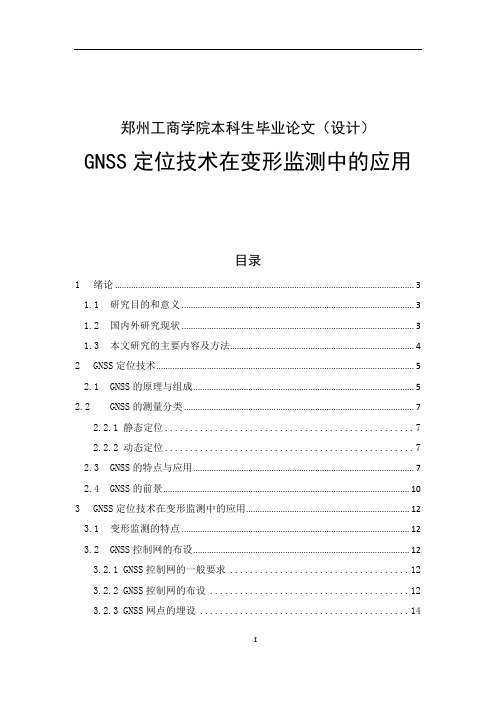
郑州工商学院本科生毕业论文(设计)GNSS定位技术在变形监测中的应用目录1绪论 (3)1.1研究目的和意义 (3)1.2国内外研究现状 (3)1.3本文研究的主要内容及方法 (4)2GNSS定位技术 (5)2.1GNSS的原理与组成 (5)2.2GNSS的测量分类 (7)2.2.1 静态定位 (7)2.2.2 动态定位 (7)2.3GNSS的特点与应用 (7)2.4GNSS的前景 (10)3GNSS定位技术在变形监测中的应用 (12)3.1变形监测的特点 (12)3.2GNSS控制网的布设 (12)3.2.1 GNSS控制网的一般要求 (12)3.2.2 GNSS控制网的布设 (12)3.2.3 GNSS网点的埋设 (14)3.3GNSS控制网的测量 (14)3.3.1 GNSS控制网的测量的精度要求 (14)3.3.2 测量过程 (15)3.3.3 数据处理和精度分析 (16)3.4变形数据的分析与预报 (16)3.4.1 分析 (16)3.4.2 预报 (17)4应用实例 (18)4.1工程简介 (18)4.2准备工作 (18)4.2.1 设备、仪器及人员组织的准备 (18)4.2.2 采用的坐标系 (18)4.3控制网的测量 (19)4.3.1 控制网的布设 (19)4.3.2 控制测量 (19)4.4数据处理与精度分析 (20)4.5变形数据分析与预报 (22)5结束语............................................................................................... 错误!未定义书签。
参考文献................................................................................................... 错误!未定义书签。
基于北斗高精定位技术的深圳机场无动力设备定位与应用研究
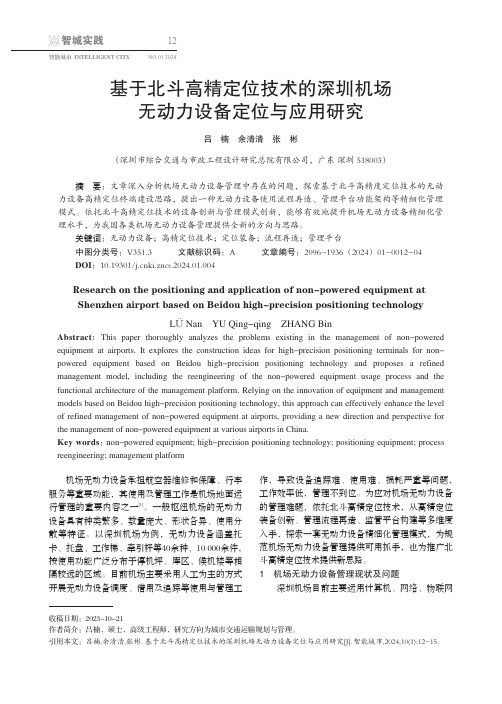
基于北斗高精定位技术的深圳机场无动力设备定位与应用研究吕楠 余清清 张彬(深圳市综合交通与市政工程设计研究总院有限公司,广东 深圳 518003)摘要:文章深入分析机场无动力设备管理中存在的问题,探索基于北斗高精度定位技术的无动力设备高精定位终端建设思路,提出一种无动力设备使用流程再造、管理平台功能架构等精细化管理模式。
依托北斗高精定位技术的设备创新与管理模式创新,能够有效地提升机场无动力设备精细化管理水平,为我国各类机场无动力设备管理提供全新的方向与思路。
关键词:无动力设备;高精定位技术;定位装备;流程再造;管理平台中图分类号:V351.3文献标识码:A文章编号:2096-1936(2024)01-0012-04DOI:10.19301/ki.zncs.2024.01.004Research on the positioning and application of non-powered equipment at Shenzhen airport based on Beidou high-precision positioning technologyLÜ Nan YU Qing-qing ZHANG BinAbstract:This paper thoroughly analyzes the problems existing in the management of non-powered equipment at airports. It explores the construction ideas for high-precision positioning terminals for non-powered equipment based on Beidou high-precision positioning technology and proposes a refined management model, including the reengineering of the non-powered equipment usage process and the functional architecture of the management platform. Relying on the innovation of equipment and management models based on Beidou high-precision positioning technology, this approach can effectively enhance the level of refined management of non-powered equipment at airports, providing a new direction and perspective for the management of non-powered equipment at various airports in China.Key words:non-powered equipment; high-precision positioning technology; positioning equipment; process reengineering; management platform机场无动力设备承担航空器维修和保障、行李服务等重要功能,其使用及管理工作是机场地面运行管理的重要内容之一[1]。
GNSS测绘技术的应用与发展趋势

GNSS测绘技术的应用与发展趋势1.引言现代测绘技术是人类文明发展的重要组成部分,而GNSS(全球导航卫星系统)作为一种高精度的测量和定位技术,正逐渐改变我们对地理空间信息的理解和运用。
本文将探讨GNSS测绘技术的应用领域以及未来的发展趋势。
2.GNSS测绘技术的应用领域2.1 土地测量与国土管理GNSS测绘技术可以快速获取大范围的地面高程和坐标数据,用于土地测量、边界划定和管理,提高土地利用效率,为国土资源规划和管理提供依据。
2.2 工程建设与监测GNSS技术在工程建设和监测中得到广泛应用。
通过实时定位和测量,工程师可以精确获得建筑物、桥梁、隧道等工程结构的坐标和变形信息,实现对工程建设过程的有效监测和控制。
2.3 海洋与航海测绘GNSS技术在海洋测绘与航海导航中发挥重要作用。
通过全球卫星的覆盖,船舶和海洋资源调查人员可以精确定位自己的位置,以及获取海洋地形、水深、海洋生态信息等。
这使得海洋资源开发和航海安全得到了极大的改善。
2.4 环境监测与资源管理GNSS技术可以用于环境监测与资源管理中。
通过获取大范围的地理空间数据,科学家可以监测气象、水文、气候变化等环境数据,并提供准确的地理空间信息,用于环境保护与气候变化应对。
3. GNSS测绘技术的发展趋势3.1 实时动态定位GNSS技术正朝着实时动态定位的方向发展。
通过利用GNSS信号传播的时间延迟,结合复杂的定位算法,可以实现厘米级或甚至毫米级的实时定位,为高精度测绘与导航提供了更加精确的数据。
3.2 多频多系统集成为了提高定位精度和抵抗GNSS信号干扰,未来的发展趋势是将多个频率和多个卫星系统进行集成。
目前,GPS系统是最常用的GNSS系统,但随着GLONASS、Galileo和北斗等系统的发展,多频多系统集成将成为实现更高精度和可靠性的关键。
3.3 增强现实与虚拟地理空间随着增强现实技术的发展,GNSS技术将与增强现实相结合,为用户提供更为直观的地理空间信息。
北斗卫星导航系统在长输管线中的应用与展望

显的行业,长输管线对北斗系统的应用才刚刚开始,可借助其他行业的经验,进一步将“长输管线+北斗”用尽、用好。
二、北斗系统应用现状2020年,我国卫星导航与位置服务产业总体产值达到4033亿元[1],标志着北斗系统已经全面进入规模化、产业化、国际化发展新阶段。
市场发展方面,卫星导航与位置服务市场需求总量基本保持稳定,呈现出三个特点:一是高精度应用发展迅速,高精度基础设施建设快速推进,高精度器件和终端产品销售规模加速增长;二是“+北斗”发展更加活跃,“行业+北斗”新生业态对市场规模和应用场景扩展产生巨大影响;三是随着卫星导航与其他技术和产业深度融合发展,卫星导航与位置服务正在向综合PNT与时空服务方向迈进,行业市场和大众市场需求正在发生深刻变化。
[2]目前北斗系统已经广泛运用于农业、交通运输、海洋渔业、防灾减灾等领域。
智慧城市、安全监控、健康监测等专业领域对卫星导航定位需求加大;高精度应用逐步向位置服务、汽车导航、智能交通、船舶导航等大众领域渗透。
高精度卫星导航定位应用的范围持续拓宽,与其他产业的融合不断深化。
2020年,随着卫星导航与其他技术和产业深度融合发展,卫星导航与位置服务正在向综合PNT 与时空服务方向迈进,行业市场和大众市场需求瞄向了更加精准、泛在、融合、安全和智能的目标,并发生着深刻变化。
三、长输管道建设北斗系统需求分析我国油气资源分布不均,长输管道可用于满足各地对石油、天然气等多种能源的需求,并且具有效率高且损耗低的特点。
目前,我国管道运输系统已基本成熟和完善,主要建成了四个国家基干天然气管网系统,分别是西气东输管道系统、陕京天然气管道系统、川气东送天然气管道系统和联络天然气管道。
笔者以陕京管道为例,来分析长输管道建设现状及需求。
1.站场巡检任务重陕京管道系统共计有各类站场、阀室304座,其中压气站10座、分输站71座、阀室223座。
压缩机共计43台,总功率611.3兆瓦。
陕西管理处位于管线源头,站场管理任务重,日常巡检耗费时间长,需投入较大人力。
北斗一号卫星导航系统定位算法及精度分析vpdf

根据文献 [ 4 ] ,气压测高方程可写yk , zk) : x k = x k0 +δ xk y k = y k0 +δ yk z k = z k0 +δ zk
给定的门限值 , 一般可取ε= 10 - 3 。
( 10 )
4 定位精度分析
采用北斗一号卫星导航定位系统标校站测量 数据 ,经各种误差修正后 , 分别解算出 7 月 6 日 0 时~7 月 7 日 0 时某标校站双星 、 三星定位结果 , 与标校站精确的大地测量成果进行比对 ,具体情况 见图 2~图 7 。
需要注意的是 , 在计算 t k 时刻接收机位置坐 标 ( x k , y k , z k ) 时 , 应采用迭代方法计算 , 用新得到 的 X 取代 X 0 作初值 , 重复上述过程 , 计算新的接
2 2 ε为 收机位置 X , 直到 δx 2 y k +δ z k <ε为止 。 k +δ
从图 2~图 5 可以看出 ,双星和三星定位结果 与标准坐标相比较 , X 方向之差在 - 25 ~ 10m 之 ・22 ・
s3 =ρ 1 + R01 +ρ 3 + R03
异常 ; N K 为 t k 时刻接收机天线相位中心的卯酉圈 曲率半径 , N K = a/ 1 - e2 sin2 B k , a 为地球椭球长 半轴 ; B k 为 t k 时刻接收机天线相位中心的大地纬 度 ; e 为地球椭球偏心率 , e2 = ( a2 - b2 ) / a2 , b 为地 球椭球短半轴 。
3. 2 观测方程线性化
以上建立的观测方程都是非线性方程 ,无法采 用一般的最优估计方法 ,如最小二乘法或卡尔曼滤 波法等进行参数估计 ,所以必须进行线性化 。在概 略坐标 ( x k0 , y k0 , z k0 ) 附近进行泰勒级数展开 , 其中 ( x k0 , y k0 , z k0 ) 可用估计坐标或前一个历元的定位 值代替 ,得出 j j j j j j δ δ δ δ ρ lk x k + mk y k + nk z k - R k0 +ρ tk - δ k - c k =ν
北斗卫星导航系统在海事领域的应用研究
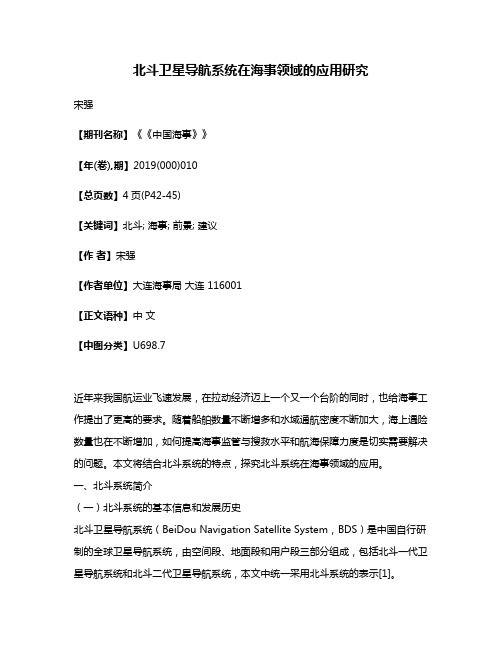
北斗卫星导航系统在海事领域的应用研究宋强【期刊名称】《《中国海事》》【年(卷),期】2019(000)010【总页数】4页(P42-45)【关键词】北斗; 海事; 前景; 建议【作者】宋强【作者单位】大连海事局大连 116001【正文语种】中文【中图分类】U698.7近年来我国航运业飞速发展,在拉动经济迈上一个又一个台阶的同时,也给海事工作提出了更高的要求。
随着船舶数量不断增多和水域通航密度不断加大,海上遇险数量也在不断增加,如何提高海事监管与搜救水平和航海保障力度是切实需要解决的问题。
本文将结合北斗系统的特点,探究北斗系统在海事领域的应用。
一、北斗系统简介(一)北斗系统的基本信息和发展历史北斗卫星导航系统(BeiDou Navigation Satellite System,BDS)是中国自行研制的全球卫星导航系统,由空间段、地面段和用户段三部分组成,包括北斗一代卫星导航系统和北斗二代卫星导航系统,本文中统一采用北斗系统的表示[1]。
北斗系统的建设规划采取了“三步走”的战略,实施北斗一号、北斗二号、北斗三号系统建设:第一步,2000年年底,建成北斗一号系统,向中国提供服务;第二步,2012年底,建成北斗二号系统,向亚太地区提供服务[2][3];第三步,建成全球导航系统。
2017年11月5日,中国第三代导航卫星顺利升空,它标志着中国正式开始建造北斗全球卫星导航系统。
2018年11月19日,我国在西昌卫星发射中心以“一箭双星”方式成功发射第四十二、四十三颗北斗导航卫星,这也是北斗三号系统第十八、十九颗组网卫星,标志着我国北斗三号基本系统星座部署完成,迈出从区域走向全球的“关键一步”。
2018年12月27日,我国宣布自主研发的北斗三号卫星系统基本完成三号系统组网,开始提供全球定位服务,北斗系统服务范围由区域扩展为全球,正式迈入全球时代。
我国正在积极推进北斗卫星导航的组网。
2019年4月20日我国成功发射第44颗北斗导航卫星,这也是北斗三号系统第二十颗组网卫星;5月17日我国成功发射第45颗北斗导航卫星,这也是北斗二号系统第四颗备份卫星。
- 1、下载文档前请自行甄别文档内容的完整性,平台不提供额外的编辑、内容补充、找答案等附加服务。
- 2、"仅部分预览"的文档,不可在线预览部分如存在完整性等问题,可反馈申请退款(可完整预览的文档不适用该条件!)。
- 3、如文档侵犯您的权益,请联系客服反馈,我们会尽快为您处理(人工客服工作时间:9:00-18:30)。
北斗卫星导航系统的毫米级精度变形监测算法与实现肖玉钢1, 姜卫平2, 陈华1, 袁鹏2, 席瑞杰11. 武汉大学测绘学院,湖北武汉430079;2. 武汉大学卫星导航定位技术研究中心,湖北武汉430079 收稿日期:2014-12-08;修回日期:2015-07-08基金项目:国家863计划(2012AA12A209);国家自然科学基金(41374033)。
第一作者简介:肖玉钢(1984—),男,博士生,研究方向为GNSS高精度定位定轨算法。
通信作者:姜卫平,wpjiang@摘要:研究了北斗卫星导航系统(BeiDou Navigation Satellite System,BDS)毫米级精度变形监测算法。
首先改进了TurboEdit方法,以能够探测到1周的小周跳;针对BDS星座结构给出更为高效的独立双差观测值搜索方法;对于模糊度固定,采用决策函数和序贯模糊度固定相结合的方法。
在此基础上,研制了BDS变形监测软件。
最后,利用变形监测试验平台的实测数据,从星座分布、解算精度等方面分析了BDS在变形监测中应用的可行性。
结果表明,目前在试验区域内BDS与GPS在卫星几何分布等方面基本相当。
BDS的短基线解算精度略低于GPS,但仍可达到平面1 mm以内、高程2 mm以内的精度水平。
关键词:北斗卫星导航系统变形监测软件实现精度分析Research and Realization of Deformation Monitoring Algorithm with Millimeter Level Precision Based on BeiDou Navigation Satellite SystemXIAO Yugang1, JIANG Weiping2, CHEN Hua1, YUAN Peng2, XI Ruijie1Abstract: The deformation monitoring algorithm with millimeter level precision based on BeiDou Navigation Satellite System (BDS) was researched. The TurboEdit method was improved to detect small cycle slips, e.g. 1 cycle. Focusing on BDS constellation, a more efficient algorithm used to construct double-differenced observations was developed. The Bootstrap+Decision function method was utilized to improve the probability of biases fixing. Based on the improved algorithm above, a deformation monitoring software based on BDS was achieved. Afterwards, the availability of BDS in the field of deformation monitoring was analyzed in terms of satellites distribution and precision and accuracy of solutions, utilizing the observations acquired from the experimental platform. The conclusion was drawn thatcurrently BDS is similar to GPS in terms of satellites distribution in the test area. The precision of short baselines derived from BDS is better than 1 mm for the horizontal components, better than 2 mm for the vertical components, which is still a little lower than GPS.Key words: BeiDou Navigation SatelliteSystem deformation monitoring software achievement precision analysis随着各种大型结构体的大量涌现以及滑坡、泥石流等地质灾害的频繁发生,变形监测研究的重要性日益突出,变形监测理论和技术方法也在迅速发展。
全球卫星导航系统(GNSS)具有全天候、高精度等优点,早在20世纪80年代中后期,就被作为一种变形监测技术手段。
1995年以来,GNSS被用于监测滑坡、大坝等缓慢变形,如在Pacoima、清江隔河岩等大坝建立的GPS 变形监测系统,对GPS用于高精度变形监测的可行性进行了分析,精度达毫米级。
结果表明,GPS解算所得变形量与水库蓄水量具有高度一致性[1, 2, 3, 4]。
为降低变形监测系统的建设成本,文献[5]提出了一机多天线变形监测系统,采用附加的多天线转换开关实现一台接收机与多个天线的时分单通连接。
同时,考虑到监测特点(如监测站坐标已知),文献[6—8]提出了“无周跳无模糊度”的变形监测方法。
对于桥梁、高大建筑物等结构体的动态变形,适宜采用实时监测系统进行,文献[9]研制了GPS变形监测数据处理软件GPSMON,定位精度为亚厘米级;文献[10]集成GPS、加速度计、伪卫星等技术,建立了桥梁变形实时监测系统。
同时,Geo++、Leica、Trimble等测量仪器公司也开发了GPS 变形监测系统,并得到了广泛的应用。
中国自20世纪80年代开始研制北斗系统,并实施了系统建设的“三步走”规划[11]。
2012年底,北斗卫星导航系统空间信号接口控制文件正式公布,标志着北斗区域导航定位系统的正式建成。
目前BDS在轨卫星16颗,其中工作卫星14颗,包括5颗GEO卫星,5颗IGSO卫星及4颗MEO卫星。
预计到2020年左右,将建成覆盖全球的北斗卫星导航系统。
已有研究表明,北斗二代系统的卫星钟性能、测距精度等与GPS基本处于同一水准[12, 13]。
在变形监测中,尤其对于滑坡、大坝等变形体的监测,受观测环境所限,测站往往遮挡严重,从而影响卫星的几何构型,降低变形监测的精度及可靠性。
BDS由于其特殊的星座设计(5颗GEO卫星以及5颗IGSO卫星的存在),即使在目前尚未完成全球构网的情况下,在我国大部分区域其卫星可见数也大于GPS 等系统。
随着BDS卫星的逐步入轨,这一优势会更加明显。
虽然BDS与GPS等类似,但其在信号结构、卫星分布、卫星类型等方面还存在较大的不同[14]。
同时,利用多种系统进行监测也可以提高监测结果的精度和可靠性。
此外,针对BDS变形监测应用的研究也可以拓展我国北斗系统的应用空间,验证北斗系统在高精度导航定位领域的可用性。
因此,研究利用BDS及联合其他系统进行变形监测具有重要的科学和现实意义。
本文首先基于双差模型研究了BDS高精度基线解算方法,并针对变形监测特点,采用可靠的数据处理策略,研制开发了一套基于BDS的变形监测软件平台。
同时,本文基于配备了三维精度测试系统的变形监测试验平台,利用在中国中部某地区采集的实测数据,从卫星分布、解算结果的内、外符合精度等多方面对北斗系统在变形监测中的可用性进行了探讨分析,并与GPS 解算结果进行了比较。
1 系统算法与实现为探讨利用现有北斗星座进行变形监测的可行性,本文研制了变形监测软件,其数据处理流程如图1所示。
本软件目标为实现BDS变形监测数据的准实时(采用时段解模式)、高精度处理,故软件采用广播星历进行解算。
已有研究表明,在短基线条件下,广播星历误差对基线解算结果的影响较小,可忽略不计[15]。
软件同时具有BDS-GPS联合解算能力,但已有研究表明目前BDS与GPS高精度解算结果之间存在由于天线相位中心改正等原因引起的系统偏差[16],因此本文仅针对BDS单模结果分析。
图1 数据处理流程Fig. 1 Data processing flow chart图选项软件包含了从数据处理到结果输出整个流程,主要包括数据准备、法方程形成与叠加、模糊度固定、时间序列结果分析等4部分。
(1) 数据准备主要包括两方面,一是根据广播星历计算卫星位置;二是将观测数据进行周跳探测与标记。
周跳探测采用改进的TurboEdit方法[17, 18],利用MW、LG组合观测值以及LC观测值的双差残差分别探测周跳。
结果表明,上述周跳探测策略基本不受电离层活动及观测条件的影响,可以探测到1周的小周跳,从而大幅减小了残差编辑的工作量,缩短了数据解算时间。
为避免周跳错误修复而引起的灾难性后果,本文对周跳采取只探测、标记而不修复的策略,对所有周跳引入模糊度参数进行估计。
(2) 形成双差观测方程,进行法方程叠加,并将模糊度映射为双差模糊度[19]。
双差观测值选取采用参考站-参考星以及全局搜索相结合的方法。
若某历元观测存在参考站或参考星,则采用参考站-参考星法,否则采用全局搜索法,在当前历元所有观测值中最大限度地搜索函数独立的双差观测值。
考虑到BDS星座的特殊性,在选择参考星时首选GEO卫星,若由于环境遮挡任何一颗GEO卫星均不为参考星,则依次选择IGSO、MEO卫星为参考星。
根据基线长度,解算时既可采用单频观测值,也可利用双频观测值形成无电离层组合以消除电离层误差的一阶影响。
形成法方程时需考虑的误差主要有对流层改正、地球自转改正、天线相位中心改正[20]、潮汐负载改正等,其他误差认为在双差过程中得到消除。
对流层改正采用Saastamoinen模型,剩余对流层影响采用分段线性模型估计。
BDS卫星天线相位中心采用MGEX(multi-GNSS experiment)公布的模型,接收机天线相位中心改正模型未知,在系统中以0代替。
求解法方程后得到浮点解,此时需进行残差编辑,对可能存在的周跳和坏值进行标记,然后重新形成法方程,直到残差编辑没有周跳或坏值为止。
(3) 模糊度固定采用决策函数和序贯模糊度固定相结合的方法进行[19]。
首先计算每个模糊度可以被固定的概率,并固定对应最大概率的模糊度,再更新法方程,重复上述程序,直到模糊度全部被固定或没有模糊度可以被固定。
结果表明,在变形监测应用中,由于基线一般较短,采用此模糊度固定策略基本可将所有的北斗双差模糊度固定。
